Report on Entrepreneurship and Small Business Venture Management
VerifiedAdded on 2021/01/01
|20
|5838
|474
Report
AI Summary
This report provides a detailed analysis of entrepreneurship and small business management, covering various types of entrepreneurial ventures and their relation to the typology of entrepreneurship. It explores the similarities and differences between these ventures, interpreting relevant data and highlighting the impact of micro and small businesses on the economy. The report also emphasizes the importance of small businesses and start-ups in contributing to the growth of the social economy. Furthermore, it identifies the characteristic traits and skills of successful entrepreneurs and assesses entrepreneurial motivation and mindset. Relevant examples are included to illustrate how background and experience can either hinder or foster entrepreneurship.

Entrepreneurship
and
Small Business
Management
and
Small Business
Management
Paraphrase This Document
Need a fresh take? Get an instant paraphrase of this document with our AI Paraphraser

EXECUTIVE SUMMARY
The assignment has been drawn upon the term entrepreneurship and how small
businesses are managed. It explains types of entrepreneurship and typology of entrepreneurial
ventures. In addition to this, the possible similarities and differences have been defined which is
necessary before deciding a particular venture type. This continues to elaborate the impact that
small businesses can create on the economy of a country which is followed by contribution of
small and start ups to the growth of social economy. Furthermore, every entrepreneur should take
inspiration from existing renowned entrepreneurs which makes them different from managers,
hence, characteristic traits and skills along with aspects of entrepreneurial personality reflection
of motivation and mindset have been covered. Together with this, all relevant examples have
been given which may foster or posses problems in entrepreneurship on the basis of background
and experience.
The assignment has been drawn upon the term entrepreneurship and how small
businesses are managed. It explains types of entrepreneurship and typology of entrepreneurial
ventures. In addition to this, the possible similarities and differences have been defined which is
necessary before deciding a particular venture type. This continues to elaborate the impact that
small businesses can create on the economy of a country which is followed by contribution of
small and start ups to the growth of social economy. Furthermore, every entrepreneur should take
inspiration from existing renowned entrepreneurs which makes them different from managers,
hence, characteristic traits and skills along with aspects of entrepreneurial personality reflection
of motivation and mindset have been covered. Together with this, all relevant examples have
been given which may foster or posses problems in entrepreneurship on the basis of background
and experience.
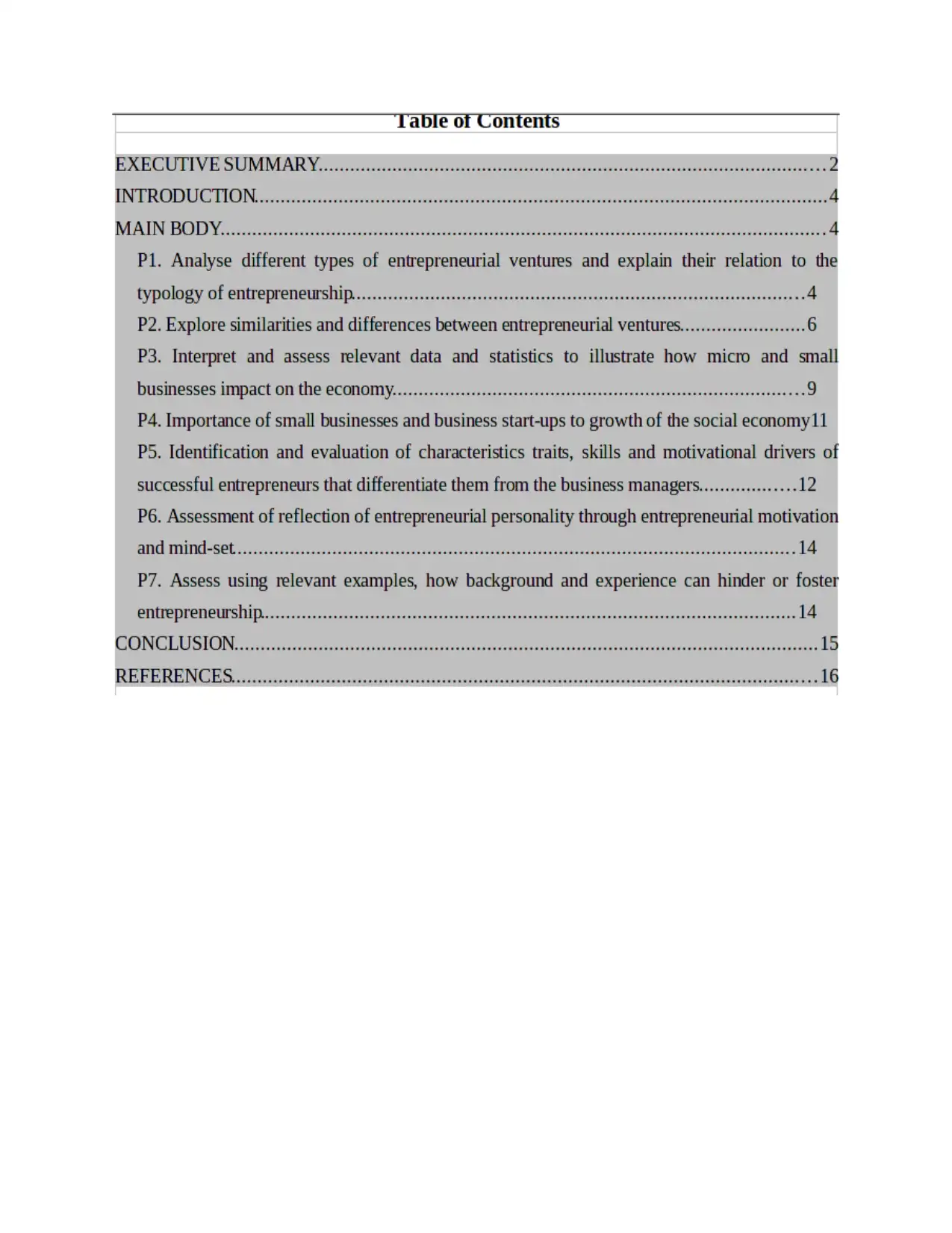
⊘ This is a preview!⊘
Do you want full access?
Subscribe today to unlock all pages.

Trusted by 1+ million students worldwide

INTRODUCTION
Entrepreneurship refers to study or process in which a person called entrepreneur creates
a business enterprise on innovative ideas and bearing the related issues with the aim of earning
profit. In comprises many functions from gathering resources to utilising them in producing
desired products or services. Such entity often starts as a small scale business however, there
should be effective management (Blackburn, Hart and Wainwright, 2013). This report exhibits
different types of entrepreneurial venture and typology of entrepreneurship, similarities and
differences between these ventures and interpretation of relevant data along with impact of micro
and small business in economy. In addition to this, importance of small businesses and start-ups
to growth of social economy, determination of characteristic traits and skills of successful
entrepreneurs and assessment of entrepreneurial motivation and mindset. Lastly, relevant
examples how background and experience can hinder or foster entrepreneurship.
MAIN BODY
P1. Analyse different types of entrepreneurial ventures and explain their relation to the typology
of entrepreneurship
Entrepreneur is an individual having ideas and sources to establish a business in which
innovation will be used to make unique goods or services that will fulfil customers' demands.
These people should have risk taking skills to make profit. There are different kinds of
entrepreneurs which are as follows:
Serial entrepreneur: This type of entrepreneurs focus on developing new ideas by using
which new businesses are established. The entrepreneur manages daily activities himself.
This involves an important role and keep experimenting with innovative ideas.
Intraprenuer: These are the employees working in an organization who have assigned
the tasks of developing innovative ideas. They have access to resources of the company
for which the ideas are being formed.
Entrepreneurship is the act of creating products, production methods, markets and form
of organizations which are completely new and fresh. In other words, conversion of a whole new
idea into a business venture by considering risks associated with the enterprise (Burns, 2016).
Enterprise is also called as undertaking which has profit motive. Entrepreneur raise
funds to invest in activities of an enterprise so that all the functions can be carried without any
Entrepreneurship refers to study or process in which a person called entrepreneur creates
a business enterprise on innovative ideas and bearing the related issues with the aim of earning
profit. In comprises many functions from gathering resources to utilising them in producing
desired products or services. Such entity often starts as a small scale business however, there
should be effective management (Blackburn, Hart and Wainwright, 2013). This report exhibits
different types of entrepreneurial venture and typology of entrepreneurship, similarities and
differences between these ventures and interpretation of relevant data along with impact of micro
and small business in economy. In addition to this, importance of small businesses and start-ups
to growth of social economy, determination of characteristic traits and skills of successful
entrepreneurs and assessment of entrepreneurial motivation and mindset. Lastly, relevant
examples how background and experience can hinder or foster entrepreneurship.
MAIN BODY
P1. Analyse different types of entrepreneurial ventures and explain their relation to the typology
of entrepreneurship
Entrepreneur is an individual having ideas and sources to establish a business in which
innovation will be used to make unique goods or services that will fulfil customers' demands.
These people should have risk taking skills to make profit. There are different kinds of
entrepreneurs which are as follows:
Serial entrepreneur: This type of entrepreneurs focus on developing new ideas by using
which new businesses are established. The entrepreneur manages daily activities himself.
This involves an important role and keep experimenting with innovative ideas.
Intraprenuer: These are the employees working in an organization who have assigned
the tasks of developing innovative ideas. They have access to resources of the company
for which the ideas are being formed.
Entrepreneurship is the act of creating products, production methods, markets and form
of organizations which are completely new and fresh. In other words, conversion of a whole new
idea into a business venture by considering risks associated with the enterprise (Burns, 2016).
Enterprise is also called as undertaking which has profit motive. Entrepreneur raise
funds to invest in activities of an enterprise so that all the functions can be carried without any
Paraphrase This Document
Need a fresh take? Get an instant paraphrase of this document with our AI Paraphraser
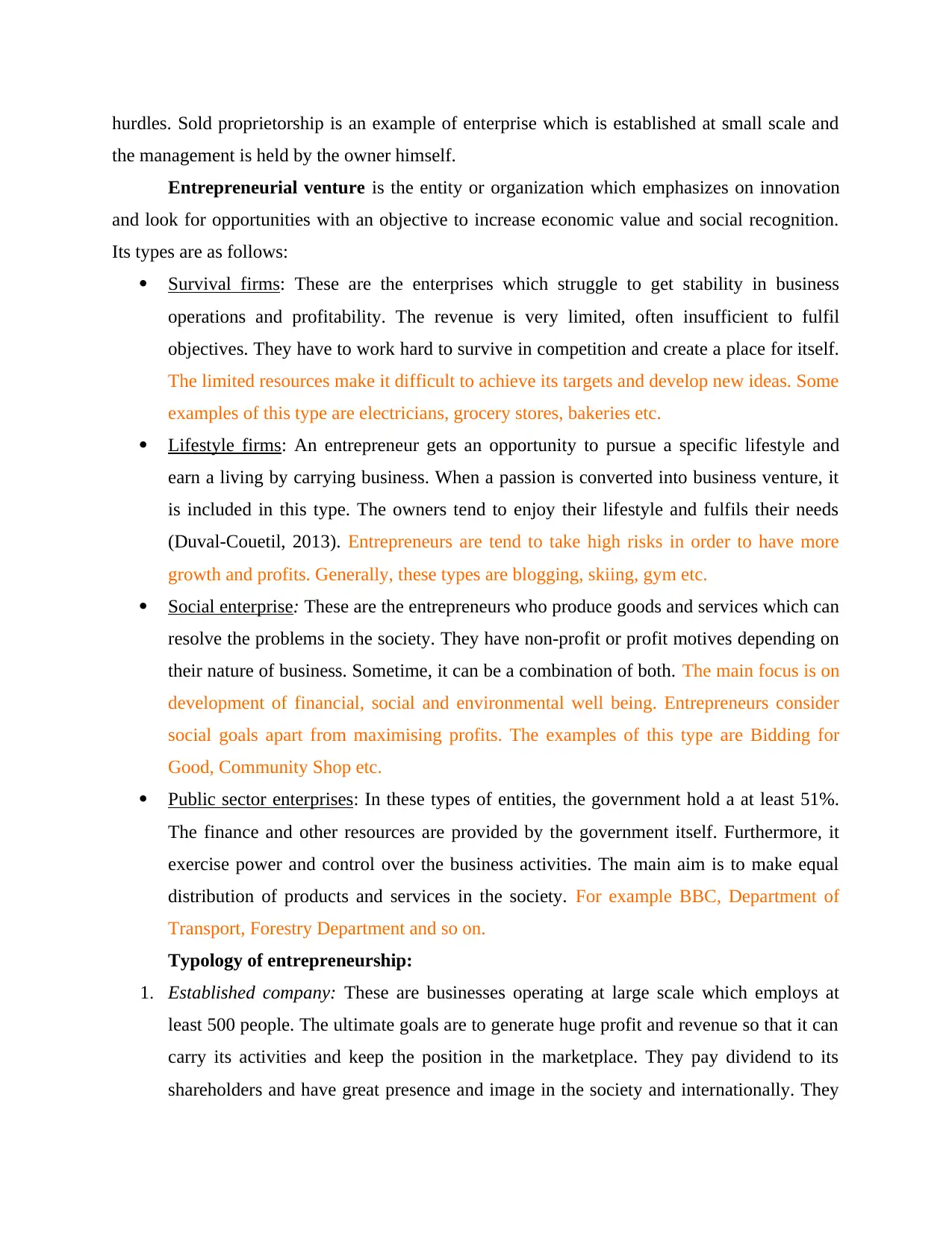
hurdles. Sold proprietorship is an example of enterprise which is established at small scale and
the management is held by the owner himself.
Entrepreneurial venture is the entity or organization which emphasizes on innovation
and look for opportunities with an objective to increase economic value and social recognition.
Its types are as follows:
Survival firms: These are the enterprises which struggle to get stability in business
operations and profitability. The revenue is very limited, often insufficient to fulfil
objectives. They have to work hard to survive in competition and create a place for itself.
The limited resources make it difficult to achieve its targets and develop new ideas. Some
examples of this type are electricians, grocery stores, bakeries etc.
Lifestyle firms: An entrepreneur gets an opportunity to pursue a specific lifestyle and
earn a living by carrying business. When a passion is converted into business venture, it
is included in this type. The owners tend to enjoy their lifestyle and fulfils their needs
(Duval‐Couetil, 2013). Entrepreneurs are tend to take high risks in order to have more
growth and profits. Generally, these types are blogging, skiing, gym etc.
Social enterprise: These are the entrepreneurs who produce goods and services which can
resolve the problems in the society. They have non-profit or profit motives depending on
their nature of business. Sometime, it can be a combination of both. The main focus is on
development of financial, social and environmental well being. Entrepreneurs consider
social goals apart from maximising profits. The examples of this type are Bidding for
Good, Community Shop etc.
Public sector enterprises: In these types of entities, the government hold a at least 51%.
The finance and other resources are provided by the government itself. Furthermore, it
exercise power and control over the business activities. The main aim is to make equal
distribution of products and services in the society. For example BBC, Department of
Transport, Forestry Department and so on.
Typology of entrepreneurship:
1. Established company: These are businesses operating at large scale which employs at
least 500 people. The ultimate goals are to generate huge profit and revenue so that it can
carry its activities and keep the position in the marketplace. They pay dividend to its
shareholders and have great presence and image in the society and internationally. They
the management is held by the owner himself.
Entrepreneurial venture is the entity or organization which emphasizes on innovation
and look for opportunities with an objective to increase economic value and social recognition.
Its types are as follows:
Survival firms: These are the enterprises which struggle to get stability in business
operations and profitability. The revenue is very limited, often insufficient to fulfil
objectives. They have to work hard to survive in competition and create a place for itself.
The limited resources make it difficult to achieve its targets and develop new ideas. Some
examples of this type are electricians, grocery stores, bakeries etc.
Lifestyle firms: An entrepreneur gets an opportunity to pursue a specific lifestyle and
earn a living by carrying business. When a passion is converted into business venture, it
is included in this type. The owners tend to enjoy their lifestyle and fulfils their needs
(Duval‐Couetil, 2013). Entrepreneurs are tend to take high risks in order to have more
growth and profits. Generally, these types are blogging, skiing, gym etc.
Social enterprise: These are the entrepreneurs who produce goods and services which can
resolve the problems in the society. They have non-profit or profit motives depending on
their nature of business. Sometime, it can be a combination of both. The main focus is on
development of financial, social and environmental well being. Entrepreneurs consider
social goals apart from maximising profits. The examples of this type are Bidding for
Good, Community Shop etc.
Public sector enterprises: In these types of entities, the government hold a at least 51%.
The finance and other resources are provided by the government itself. Furthermore, it
exercise power and control over the business activities. The main aim is to make equal
distribution of products and services in the society. For example BBC, Department of
Transport, Forestry Department and so on.
Typology of entrepreneurship:
1. Established company: These are businesses operating at large scale which employs at
least 500 people. The ultimate goals are to generate huge profit and revenue so that it can
carry its activities and keep the position in the marketplace. They pay dividend to its
shareholders and have great presence and image in the society and internationally. They
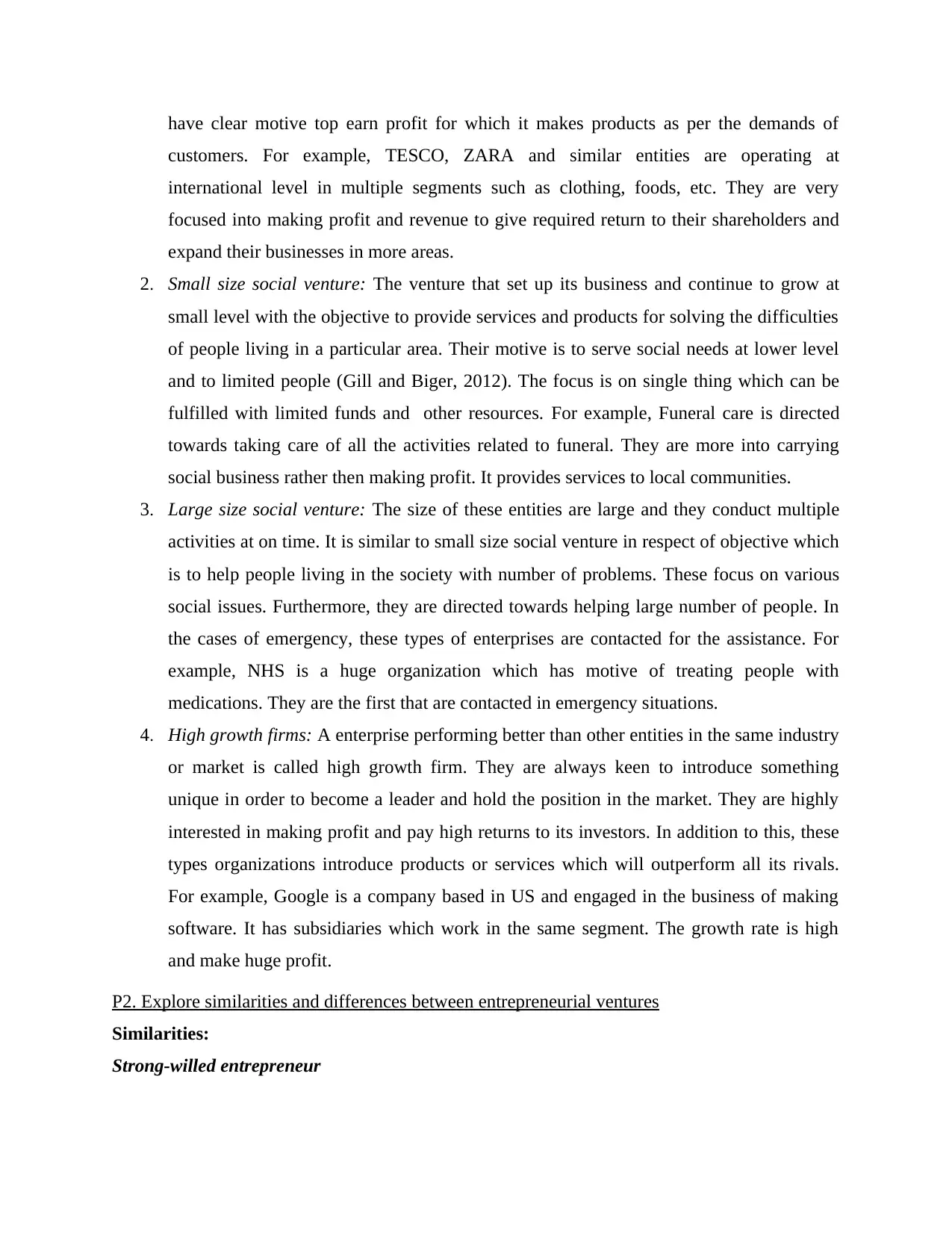
have clear motive top earn profit for which it makes products as per the demands of
customers. For example, TESCO, ZARA and similar entities are operating at
international level in multiple segments such as clothing, foods, etc. They are very
focused into making profit and revenue to give required return to their shareholders and
expand their businesses in more areas.
2. Small size social venture: The venture that set up its business and continue to grow at
small level with the objective to provide services and products for solving the difficulties
of people living in a particular area. Their motive is to serve social needs at lower level
and to limited people (Gill and Biger, 2012). The focus is on single thing which can be
fulfilled with limited funds and other resources. For example, Funeral care is directed
towards taking care of all the activities related to funeral. They are more into carrying
social business rather then making profit. It provides services to local communities.
3. Large size social venture: The size of these entities are large and they conduct multiple
activities at on time. It is similar to small size social venture in respect of objective which
is to help people living in the society with number of problems. These focus on various
social issues. Furthermore, they are directed towards helping large number of people. In
the cases of emergency, these types of enterprises are contacted for the assistance. For
example, NHS is a huge organization which has motive of treating people with
medications. They are the first that are contacted in emergency situations.
4. High growth firms: A enterprise performing better than other entities in the same industry
or market is called high growth firm. They are always keen to introduce something
unique in order to become a leader and hold the position in the market. They are highly
interested in making profit and pay high returns to its investors. In addition to this, these
types organizations introduce products or services which will outperform all its rivals.
For example, Google is a company based in US and engaged in the business of making
software. It has subsidiaries which work in the same segment. The growth rate is high
and make huge profit.
P2. Explore similarities and differences between entrepreneurial ventures
Similarities:
Strong-willed entrepreneur
customers. For example, TESCO, ZARA and similar entities are operating at
international level in multiple segments such as clothing, foods, etc. They are very
focused into making profit and revenue to give required return to their shareholders and
expand their businesses in more areas.
2. Small size social venture: The venture that set up its business and continue to grow at
small level with the objective to provide services and products for solving the difficulties
of people living in a particular area. Their motive is to serve social needs at lower level
and to limited people (Gill and Biger, 2012). The focus is on single thing which can be
fulfilled with limited funds and other resources. For example, Funeral care is directed
towards taking care of all the activities related to funeral. They are more into carrying
social business rather then making profit. It provides services to local communities.
3. Large size social venture: The size of these entities are large and they conduct multiple
activities at on time. It is similar to small size social venture in respect of objective which
is to help people living in the society with number of problems. These focus on various
social issues. Furthermore, they are directed towards helping large number of people. In
the cases of emergency, these types of enterprises are contacted for the assistance. For
example, NHS is a huge organization which has motive of treating people with
medications. They are the first that are contacted in emergency situations.
4. High growth firms: A enterprise performing better than other entities in the same industry
or market is called high growth firm. They are always keen to introduce something
unique in order to become a leader and hold the position in the market. They are highly
interested in making profit and pay high returns to its investors. In addition to this, these
types organizations introduce products or services which will outperform all its rivals.
For example, Google is a company based in US and engaged in the business of making
software. It has subsidiaries which work in the same segment. The growth rate is high
and make huge profit.
P2. Explore similarities and differences between entrepreneurial ventures
Similarities:
Strong-willed entrepreneur
⊘ This is a preview!⊘
Do you want full access?
Subscribe today to unlock all pages.

Trusted by 1+ million students worldwide
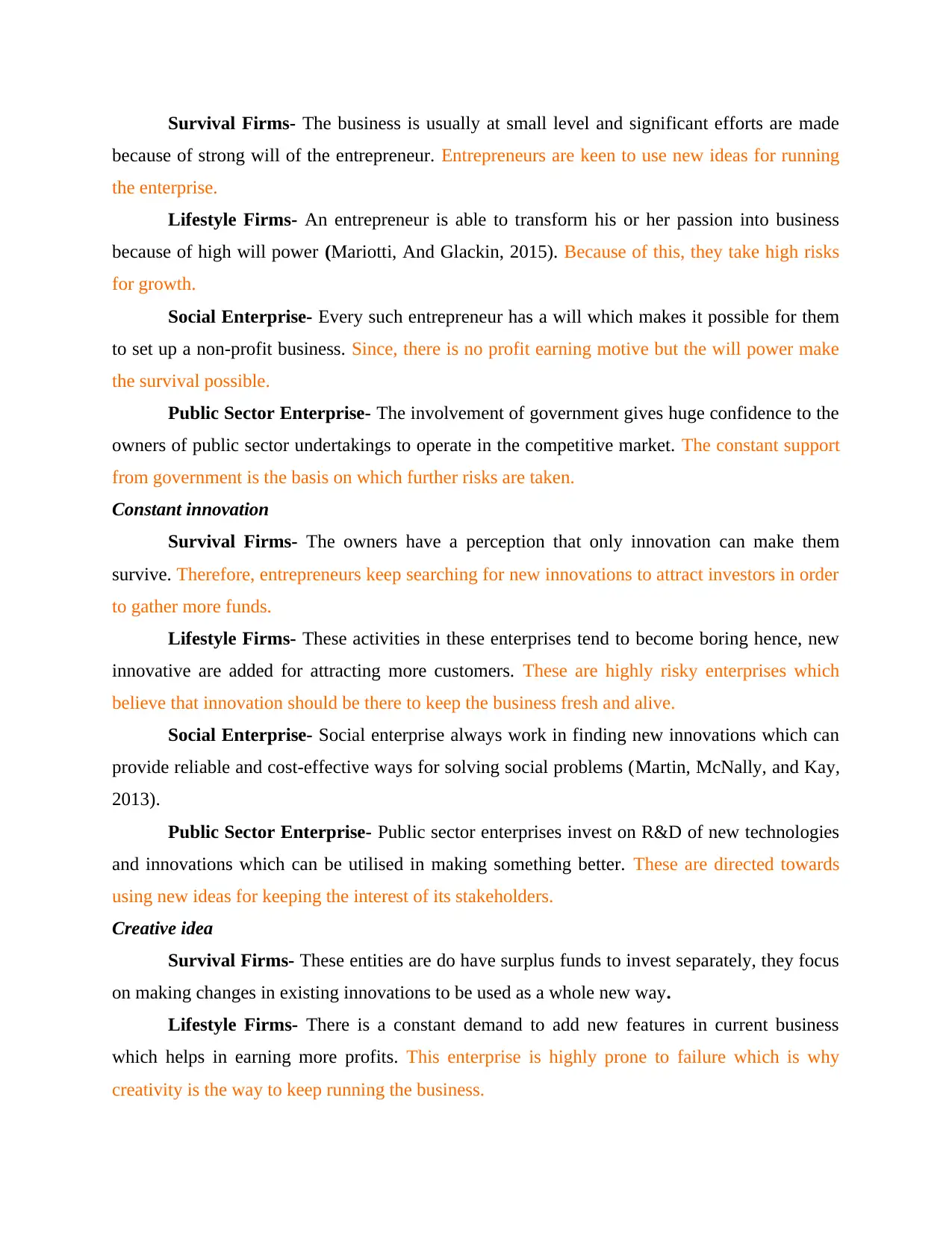
Survival Firms- The business is usually at small level and significant efforts are made
because of strong will of the entrepreneur. Entrepreneurs are keen to use new ideas for running
the enterprise.
Lifestyle Firms- An entrepreneur is able to transform his or her passion into business
because of high will power (Mariotti, And Glackin, 2015). Because of this, they take high risks
for growth.
Social Enterprise- Every such entrepreneur has a will which makes it possible for them
to set up a non-profit business. Since, there is no profit earning motive but the will power make
the survival possible.
Public Sector Enterprise- The involvement of government gives huge confidence to the
owners of public sector undertakings to operate in the competitive market. The constant support
from government is the basis on which further risks are taken.
Constant innovation
Survival Firms- The owners have a perception that only innovation can make them
survive. Therefore, entrepreneurs keep searching for new innovations to attract investors in order
to gather more funds.
Lifestyle Firms- These activities in these enterprises tend to become boring hence, new
innovative are added for attracting more customers. These are highly risky enterprises which
believe that innovation should be there to keep the business fresh and alive.
Social Enterprise- Social enterprise always work in finding new innovations which can
provide reliable and cost-effective ways for solving social problems (Martin, McNally, and Kay,
2013).
Public Sector Enterprise- Public sector enterprises invest on R&D of new technologies
and innovations which can be utilised in making something better. These are directed towards
using new ideas for keeping the interest of its stakeholders.
Creative idea
Survival Firms- These entities are do have surplus funds to invest separately, they focus
on making changes in existing innovations to be used as a whole new way.
Lifestyle Firms- There is a constant demand to add new features in current business
which helps in earning more profits. This enterprise is highly prone to failure which is why
creativity is the way to keep running the business.
because of strong will of the entrepreneur. Entrepreneurs are keen to use new ideas for running
the enterprise.
Lifestyle Firms- An entrepreneur is able to transform his or her passion into business
because of high will power (Mariotti, And Glackin, 2015). Because of this, they take high risks
for growth.
Social Enterprise- Every such entrepreneur has a will which makes it possible for them
to set up a non-profit business. Since, there is no profit earning motive but the will power make
the survival possible.
Public Sector Enterprise- The involvement of government gives huge confidence to the
owners of public sector undertakings to operate in the competitive market. The constant support
from government is the basis on which further risks are taken.
Constant innovation
Survival Firms- The owners have a perception that only innovation can make them
survive. Therefore, entrepreneurs keep searching for new innovations to attract investors in order
to gather more funds.
Lifestyle Firms- These activities in these enterprises tend to become boring hence, new
innovative are added for attracting more customers. These are highly risky enterprises which
believe that innovation should be there to keep the business fresh and alive.
Social Enterprise- Social enterprise always work in finding new innovations which can
provide reliable and cost-effective ways for solving social problems (Martin, McNally, and Kay,
2013).
Public Sector Enterprise- Public sector enterprises invest on R&D of new technologies
and innovations which can be utilised in making something better. These are directed towards
using new ideas for keeping the interest of its stakeholders.
Creative idea
Survival Firms- These entities are do have surplus funds to invest separately, they focus
on making changes in existing innovations to be used as a whole new way.
Lifestyle Firms- There is a constant demand to add new features in current business
which helps in earning more profits. This enterprise is highly prone to failure which is why
creativity is the way to keep running the business.
Paraphrase This Document
Need a fresh take? Get an instant paraphrase of this document with our AI Paraphraser

Social Enterprise- They find creative ideas to engage people for getting the best
outcomes. The contribution to creativity can also be done by its members to become successful
in achieving its goals.
Public Sector Enterprise- These enterprises are into creativity whereby new ideas are
experimented on already developed innovative product. Furthermore, public are involved for
obtaining their opinions in developing creative ideas.
Sustaining against large businesses
Survival Firms- The small businesses implement strategies to survive against large
corporations (Morris, M. H. and et. al., 2013). It gives time and efforts in running the business so
that long sustainability can be maintained.
Lifestyle Firms- These bring uniqueness in their business for providing whole new
products. These enterprises keep on bringing something new to make the business achieve its
targets.
Social Enterprise- It survive by producing products or services which will increase
customer's satisfaction. Members' contribution to designing the products is a way to manage the
business for a long term.
Public Sector Enterprise- These are usually large scale, however, there is a huge
competition which is reduced through collaboration and alliances.
The scale of operating a business depends upon number of factors such as investment,
innovation, creative idea etc. Entrepreneur considers the venture which is suitable from all the
angles. Small business may have to face difficulties in survival but they have innovation in ideas.
Differences:
Annual Growth Rate
Survival Firms- These have to struggle a lot to earn profit and revenue which sometimes
is insufficient to pay its own debts. Hence, this rate is very low. There is limited scope for these
enterprises to grab opportunities for growth.
Lifestyle Firms- The can be change in the trends and preferences of customers, which
may affect the business the annual growth rate is fluctuating. The business is on positive side
only in the season. If the season is over, the graph of profit starts declining.
outcomes. The contribution to creativity can also be done by its members to become successful
in achieving its goals.
Public Sector Enterprise- These enterprises are into creativity whereby new ideas are
experimented on already developed innovative product. Furthermore, public are involved for
obtaining their opinions in developing creative ideas.
Sustaining against large businesses
Survival Firms- The small businesses implement strategies to survive against large
corporations (Morris, M. H. and et. al., 2013). It gives time and efforts in running the business so
that long sustainability can be maintained.
Lifestyle Firms- These bring uniqueness in their business for providing whole new
products. These enterprises keep on bringing something new to make the business achieve its
targets.
Social Enterprise- It survive by producing products or services which will increase
customer's satisfaction. Members' contribution to designing the products is a way to manage the
business for a long term.
Public Sector Enterprise- These are usually large scale, however, there is a huge
competition which is reduced through collaboration and alliances.
The scale of operating a business depends upon number of factors such as investment,
innovation, creative idea etc. Entrepreneur considers the venture which is suitable from all the
angles. Small business may have to face difficulties in survival but they have innovation in ideas.
Differences:
Annual Growth Rate
Survival Firms- These have to struggle a lot to earn profit and revenue which sometimes
is insufficient to pay its own debts. Hence, this rate is very low. There is limited scope for these
enterprises to grab opportunities for growth.
Lifestyle Firms- The can be change in the trends and preferences of customers, which
may affect the business the annual growth rate is fluctuating. The business is on positive side
only in the season. If the season is over, the graph of profit starts declining.
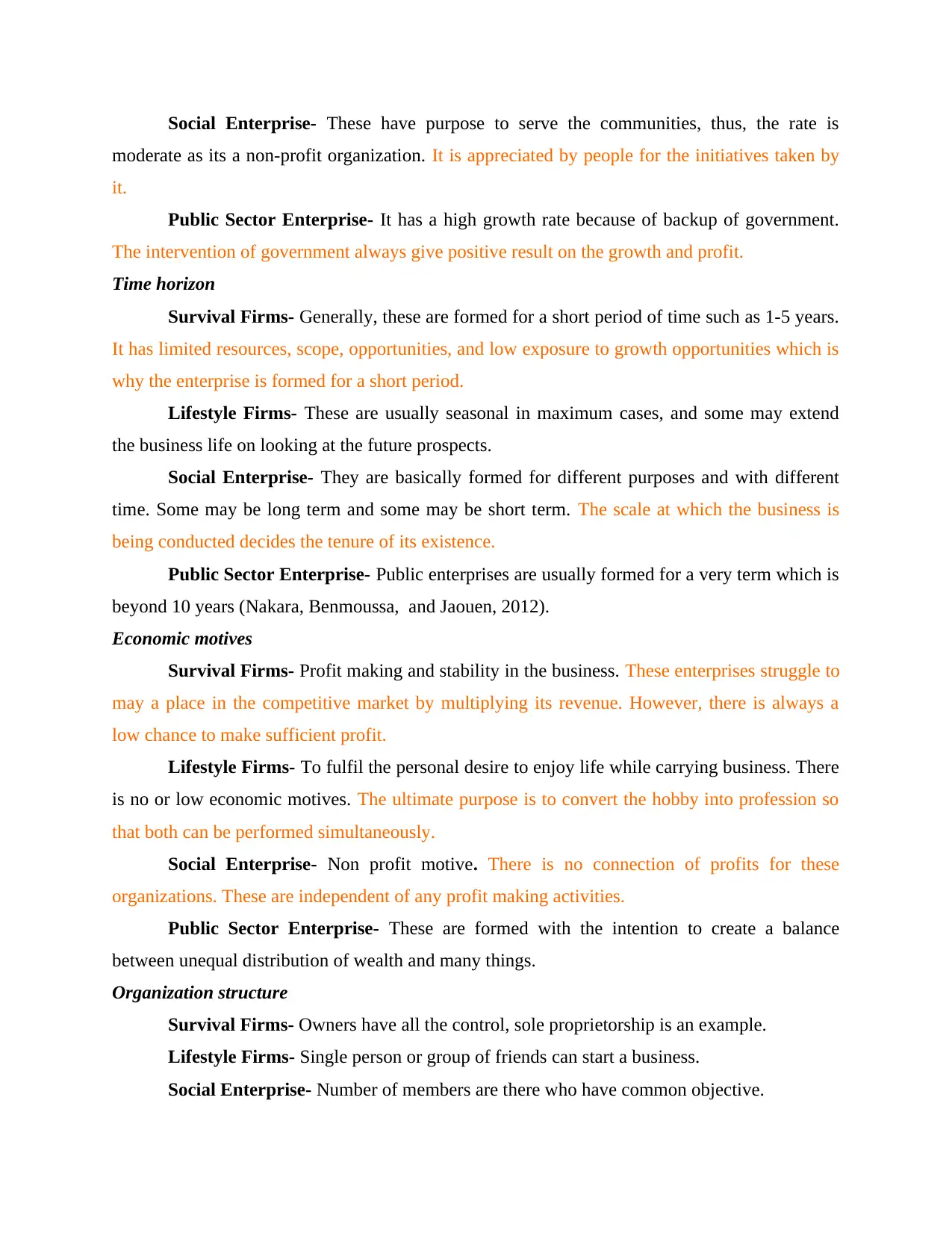
Social Enterprise- These have purpose to serve the communities, thus, the rate is
moderate as its a non-profit organization. It is appreciated by people for the initiatives taken by
it.
Public Sector Enterprise- It has a high growth rate because of backup of government.
The intervention of government always give positive result on the growth and profit.
Time horizon
Survival Firms- Generally, these are formed for a short period of time such as 1-5 years.
It has limited resources, scope, opportunities, and low exposure to growth opportunities which is
why the enterprise is formed for a short period.
Lifestyle Firms- These are usually seasonal in maximum cases, and some may extend
the business life on looking at the future prospects.
Social Enterprise- They are basically formed for different purposes and with different
time. Some may be long term and some may be short term. The scale at which the business is
being conducted decides the tenure of its existence.
Public Sector Enterprise- Public enterprises are usually formed for a very term which is
beyond 10 years (Nakara, Benmoussa, and Jaouen, 2012).
Economic motives
Survival Firms- Profit making and stability in the business. These enterprises struggle to
may a place in the competitive market by multiplying its revenue. However, there is always a
low chance to make sufficient profit.
Lifestyle Firms- To fulfil the personal desire to enjoy life while carrying business. There
is no or low economic motives. The ultimate purpose is to convert the hobby into profession so
that both can be performed simultaneously.
Social Enterprise- Non profit motive. There is no connection of profits for these
organizations. These are independent of any profit making activities.
Public Sector Enterprise- These are formed with the intention to create a balance
between unequal distribution of wealth and many things.
Organization structure
Survival Firms- Owners have all the control, sole proprietorship is an example.
Lifestyle Firms- Single person or group of friends can start a business.
Social Enterprise- Number of members are there who have common objective.
moderate as its a non-profit organization. It is appreciated by people for the initiatives taken by
it.
Public Sector Enterprise- It has a high growth rate because of backup of government.
The intervention of government always give positive result on the growth and profit.
Time horizon
Survival Firms- Generally, these are formed for a short period of time such as 1-5 years.
It has limited resources, scope, opportunities, and low exposure to growth opportunities which is
why the enterprise is formed for a short period.
Lifestyle Firms- These are usually seasonal in maximum cases, and some may extend
the business life on looking at the future prospects.
Social Enterprise- They are basically formed for different purposes and with different
time. Some may be long term and some may be short term. The scale at which the business is
being conducted decides the tenure of its existence.
Public Sector Enterprise- Public enterprises are usually formed for a very term which is
beyond 10 years (Nakara, Benmoussa, and Jaouen, 2012).
Economic motives
Survival Firms- Profit making and stability in the business. These enterprises struggle to
may a place in the competitive market by multiplying its revenue. However, there is always a
low chance to make sufficient profit.
Lifestyle Firms- To fulfil the personal desire to enjoy life while carrying business. There
is no or low economic motives. The ultimate purpose is to convert the hobby into profession so
that both can be performed simultaneously.
Social Enterprise- Non profit motive. There is no connection of profits for these
organizations. These are independent of any profit making activities.
Public Sector Enterprise- These are formed with the intention to create a balance
between unequal distribution of wealth and many things.
Organization structure
Survival Firms- Owners have all the control, sole proprietorship is an example.
Lifestyle Firms- Single person or group of friends can start a business.
Social Enterprise- Number of members are there who have common objective.
⊘ This is a preview!⊘
Do you want full access?
Subscribe today to unlock all pages.

Trusted by 1+ million students worldwide

Public Sector Enterprise- Public and government are involved and follow
centralisation.
Exit approach
Survival Firms- Easy to dissolve. Since, the investment in the business is low and there
is no increased formalities. Therefore, it is much easier to wind up the enterprise.
Lifestyle Firms- There is no much difficulty in exit from the market.
Social Enterprise- Easy.
Public Sector Enterprise- Difficult. Without the permission of government, no exit.
Differences care always there with each types of typology. Every business venture
depends upon what other have created. Some of the business ventures have differences in a
major way which must be considered.
P3. Interpret and assess relevant data and statistics to illustrate how micro and small businesses
impact on the economy
Micro businesses are the one operating at lower level which is small in nature. These are
usually the start-ups having low growth potential. They are prone to number of difficulties which
can make it hard to survive in the tough competition. Government make policies to boost their
businesses. In UK, an entity having a turnover of £2 million and employees of less than 10.
generated revenue is too low to survive in challenges (Sampaio, Thomas and Font, 2012).
Small businesses are the one who conduct activities as a retailer. They are at upper scale
as compared to micro entities and have better access to sources of funds. Some of its instances
are corporations, partnerships, etc. They invest funds in a limited quantity which can make it
easy to carry operations. UK legislation has defined, an enterprise employing not more than 50
and having turnover up to £10 million is included under this category.
The following are the statistics of SME and its conditions in UK:
centralisation.
Exit approach
Survival Firms- Easy to dissolve. Since, the investment in the business is low and there
is no increased formalities. Therefore, it is much easier to wind up the enterprise.
Lifestyle Firms- There is no much difficulty in exit from the market.
Social Enterprise- Easy.
Public Sector Enterprise- Difficult. Without the permission of government, no exit.
Differences care always there with each types of typology. Every business venture
depends upon what other have created. Some of the business ventures have differences in a
major way which must be considered.
P3. Interpret and assess relevant data and statistics to illustrate how micro and small businesses
impact on the economy
Micro businesses are the one operating at lower level which is small in nature. These are
usually the start-ups having low growth potential. They are prone to number of difficulties which
can make it hard to survive in the tough competition. Government make policies to boost their
businesses. In UK, an entity having a turnover of £2 million and employees of less than 10.
generated revenue is too low to survive in challenges (Sampaio, Thomas and Font, 2012).
Small businesses are the one who conduct activities as a retailer. They are at upper scale
as compared to micro entities and have better access to sources of funds. Some of its instances
are corporations, partnerships, etc. They invest funds in a limited quantity which can make it
easy to carry operations. UK legislation has defined, an enterprise employing not more than 50
and having turnover up to £10 million is included under this category.
The following are the statistics of SME and its conditions in UK:
Paraphrase This Document
Need a fresh take? Get an instant paraphrase of this document with our AI Paraphraser

Figure 1: Main industry or sector of SME in UK market
It can be seen that, service industry is preferred in carrying business under SME. There is
a huge scope for small and micro businesses to start their business in service sector. The data of
2018, discloses that about 17% are engaged in personal services which includes beauty, wellness
etc. and another 17% are carrying professional services financial, consultancy etc.
It can be seen that, service industry is preferred in carrying business under SME. There is
a huge scope for small and micro businesses to start their business in service sector. The data of
2018, discloses that about 17% are engaged in personal services which includes beauty, wellness
etc. and another 17% are carrying professional services financial, consultancy etc.
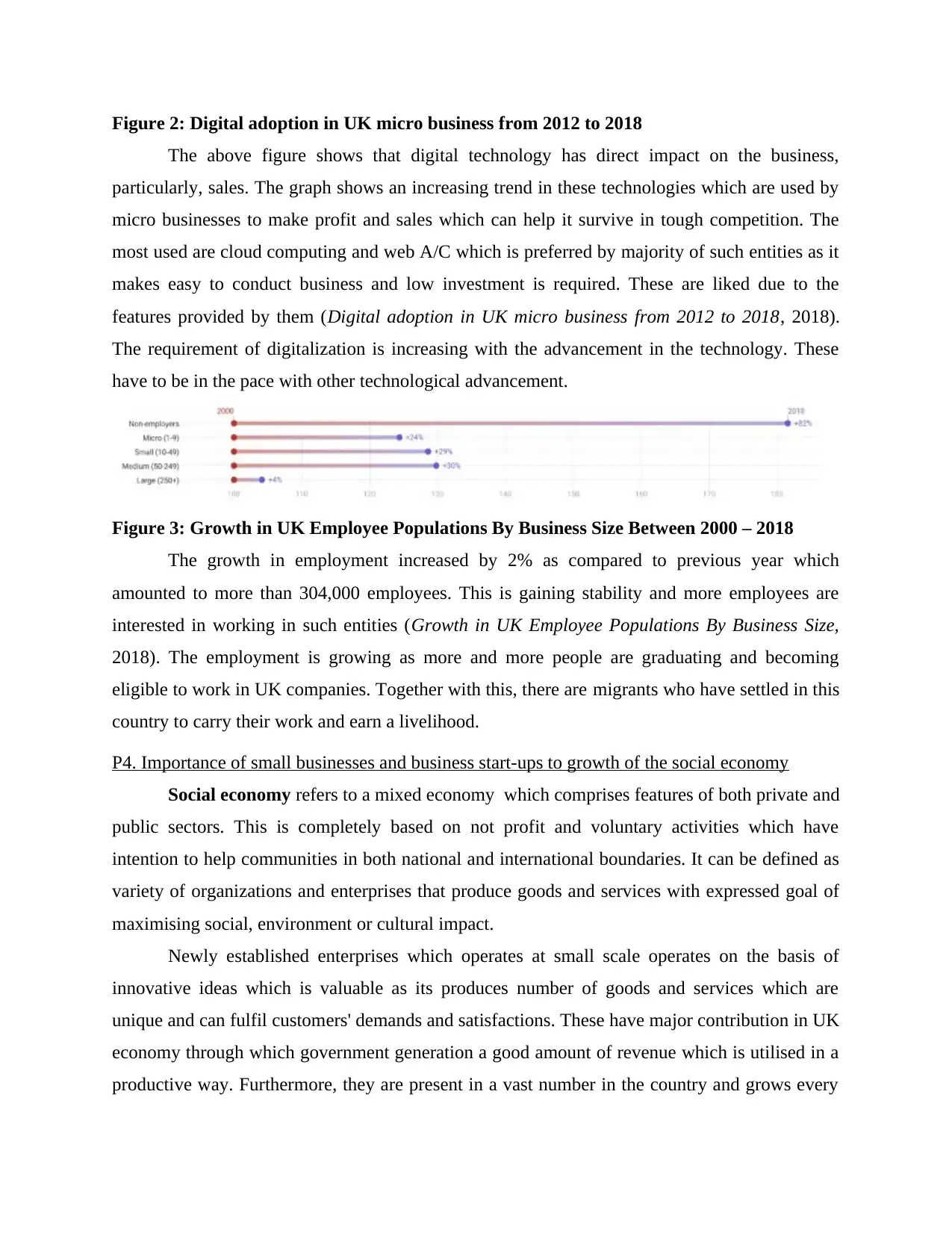
Figure 2: Digital adoption in UK micro business from 2012 to 2018
The above figure shows that digital technology has direct impact on the business,
particularly, sales. The graph shows an increasing trend in these technologies which are used by
micro businesses to make profit and sales which can help it survive in tough competition. The
most used are cloud computing and web A/C which is preferred by majority of such entities as it
makes easy to conduct business and low investment is required. These are liked due to the
features provided by them (Digital adoption in UK micro business from 2012 to 2018, 2018).
The requirement of digitalization is increasing with the advancement in the technology. These
have to be in the pace with other technological advancement.
Figure 3: Growth in UK Employee Populations By Business Size Between 2000 – 2018
The growth in employment increased by 2% as compared to previous year which
amounted to more than 304,000 employees. This is gaining stability and more employees are
interested in working in such entities (Growth in UK Employee Populations By Business Size,
2018). The employment is growing as more and more people are graduating and becoming
eligible to work in UK companies. Together with this, there are migrants who have settled in this
country to carry their work and earn a livelihood.
P4. Importance of small businesses and business start-ups to growth of the social economy
Social economy refers to a mixed economy which comprises features of both private and
public sectors. This is completely based on not profit and voluntary activities which have
intention to help communities in both national and international boundaries. It can be defined as
variety of organizations and enterprises that produce goods and services with expressed goal of
maximising social, environment or cultural impact.
Newly established enterprises which operates at small scale operates on the basis of
innovative ideas which is valuable as its produces number of goods and services which are
unique and can fulfil customers' demands and satisfactions. These have major contribution in UK
economy through which government generation a good amount of revenue which is utilised in a
productive way. Furthermore, they are present in a vast number in the country and grows every
The above figure shows that digital technology has direct impact on the business,
particularly, sales. The graph shows an increasing trend in these technologies which are used by
micro businesses to make profit and sales which can help it survive in tough competition. The
most used are cloud computing and web A/C which is preferred by majority of such entities as it
makes easy to conduct business and low investment is required. These are liked due to the
features provided by them (Digital adoption in UK micro business from 2012 to 2018, 2018).
The requirement of digitalization is increasing with the advancement in the technology. These
have to be in the pace with other technological advancement.
Figure 3: Growth in UK Employee Populations By Business Size Between 2000 – 2018
The growth in employment increased by 2% as compared to previous year which
amounted to more than 304,000 employees. This is gaining stability and more employees are
interested in working in such entities (Growth in UK Employee Populations By Business Size,
2018). The employment is growing as more and more people are graduating and becoming
eligible to work in UK companies. Together with this, there are migrants who have settled in this
country to carry their work and earn a livelihood.
P4. Importance of small businesses and business start-ups to growth of the social economy
Social economy refers to a mixed economy which comprises features of both private and
public sectors. This is completely based on not profit and voluntary activities which have
intention to help communities in both national and international boundaries. It can be defined as
variety of organizations and enterprises that produce goods and services with expressed goal of
maximising social, environment or cultural impact.
Newly established enterprises which operates at small scale operates on the basis of
innovative ideas which is valuable as its produces number of goods and services which are
unique and can fulfil customers' demands and satisfactions. These have major contribution in UK
economy through which government generation a good amount of revenue which is utilised in a
productive way. Furthermore, they are present in a vast number in the country and grows every
⊘ This is a preview!⊘
Do you want full access?
Subscribe today to unlock all pages.

Trusted by 1+ million students worldwide
1 out of 20
Related Documents
Your All-in-One AI-Powered Toolkit for Academic Success.
+13062052269
info@desklib.com
Available 24*7 on WhatsApp / Email
![[object Object]](/_next/static/media/star-bottom.7253800d.svg)
Unlock your academic potential
Copyright © 2020–2025 A2Z Services. All Rights Reserved. Developed and managed by ZUCOL.




